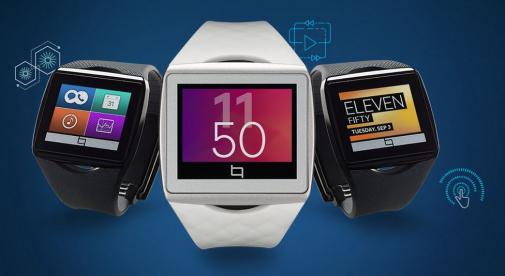As the CES pre-announcements pour in, it’s clear that a leading feature of this year’s electronics extravaganza will be wearable devices of all types. Smart watches will make the biggest splash, but I have grave doubts about this category’s chances for success. On the other hand, small, no-display wearables built on sensor technologies are likely to have a big impact over time.
I have been using a Qualcomm Toq watch for the past couple of weeks, and while I find it a very interesting technology demo, it fails a very basic test as a product: I cannot figure out what problem I have to which the Toq is an answer. Unlike many of my younger colleagues, I don’t feel fully dressed without a watch, even though my omnipresent mobile phone serves perfectly well as a timepiece. But I am not about to trade the elegant Baume et Mercier that I have worn for years for a big chunk of plastic.
The Tog does a fine job of relaying selected information–incoming calls, messages, email headers, stock prices, weather, and more–from an Android phone, currently a Moto G, to my wrist. But I can get all that information and a great deal more just by fishing the phone out of my pocket. I just don’t gain enough from a smart watch to justify wearing one.
Not that the Toq is without its interesting features. At the top of the list is its Mirasol display. This is a reflective dichroic technology the, like E Ink, requires no power to maintain a persistent image but, unlike E Ink, displays full color. This makes it possible to have a display that is always on, as a watch should be, and still be able to go for up to a week without recharging (wirelessly, in the case of the Toq.) The color is considerably less vibrant than an LCD or OLED display (and less saturated than in the Qualcomm photo above), but it’s not bad and the reflective technology means that the quality of the image actually improves in bright light. The big problem with Mirasol is that Qualcomm, which has been working on the technology for several years, has had a lot of trouble manufacturing it at scale. Even now, it’s not clear that Mirasol displays can be produced competitively in sizes than the Toq’s 1.55 inches.
Pure sensor wearables have a lot more appeal. So far, the field has been dominated by two types of devices. Fitness sensors, such as those from Fitbit, Nike, and Jawbone, with a very limited or no display and medical sensors, such as heart rate or respiration monitors, that mostly are regulated as Class 1 or Class 2 medical devices.
The potential for big improvements in sensors is coming from technologies like the M7 chip in the Apple iPhone 5s and the X1 chipset in the Moto X. These combine accelerometers, gyroscopes, and compasses to give six-axis motion sensing with memory and a low-powered processor. The result is a device that is able to log motion over a long period of time with very little power consumption. If these technologies are moved into a separate device and combined with a Bluetooth LE (low energy) radio, you have a freestanding device that can record sensor measurements for an extended period and upload the data for analysis only when it is convenient. If the devices get small enough and cheap enough, they could be built into clothing, athletic equipment, or pretty much anything else you can imagine.
Thinking hard about the smart watch, I have not been able to come up with a reason why I would want one (and why, despite persistent rumors, I don’t think Apple will go beyond internal experiments with the design.) But let your imagination roam and you can come up with all manner of uses for wearable or embeddable sensors. That’s where the action will be.

I’ve always thought the smart watch was like the Segway: a concept in search of a need. It has sold about as well as the Segway, too, and it’ll probably continue to do that.
Seems like a smart watch could have some nice niche markets, if the makers played it smart—such as scuba diving and such. You know, all those niche markets that exist already for watches, where there are real problems to be solved.
Joe
it’s awesome article. I look forward to the continuation.
Excellent article! We will be linking to this particularly great article on our website. Keep up the good writing.
Excellent article! We will be linking to this particularly great article on our website. Keep up the good writing.